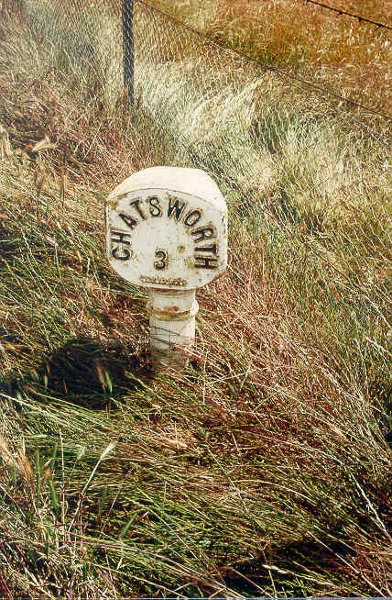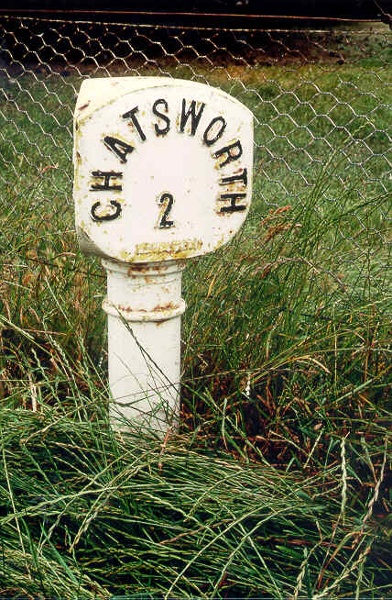Back to search results
CAST IRON MILEPOSTS
CHATSWORTH-WICKLIFFE ROAD AND 534 CHATSWORTH-WICKLIFFE ROAD CHATSWORTH, ARARAT RURAL CITY, MOYNE SHIRE
CAST IRON MILEPOSTS
CHATSWORTH-WICKLIFFE ROAD AND 534 CHATSWORTH-WICKLIFFE ROAD CHATSWORTH, ARARAT RURAL CITY, MOYNE SHIRE
All information on this page is maintained by Heritage Victoria.
Click below for their website and contact details.
Victorian Heritage Register
-
Add to tour
You must log in to do that.
-
Share
-
Shortlist place
You must log in to do that.
- Download report

1 cast iron mile posts caramut 3 miles



On this page:
Statement of Significance
What is significant?
The cast iron mileposts on the Chatsworth Wickliffe Road near Chatsworth were made by Robison Brothers & Co of Melbourne. The date of manufacture is unknown but is believed to be early 1900s. The triangular head of the post sits above a 100mm diameter round section. The face of the triangular sectionmeasures approximately 200mm x 200mm. The seams of the surfaces in the triangular section appear to be welded together. The mileposts along the Chatsworth Wickliffe Road read (B1): Wickliffe 10 - Chatsworth 2 and (B2): Wickliffe 9 - Chatsworth 3.
How is it significant?
The cast iron mileposts on the Chatsworth Wickliffe Road are of historical significance to the State of Victoria.
Why is it significant?
The cast iron mileposts on the Chatsworth Wickliffe Road are of historical significance for their association with the development of early Victoria. Road construction was accelerated following the economic boom of the gold rushes in Victoria and the mileposts were a direct response to this, trying to rationalise the road system of a developing colony. The cast iron mileposts on the Chatsworth Wickliffe Road assist in a greater understanding of the development and impact of 19th century economic activity in the State and the resultant need for transport systems. The mileposts on the Chatsworth Wickliffe Road are a visual reminder of the evolution of Victoria's infrastructure and the past imperial system of measurements and weights. The mileposts are of historical importance for their ability to describe transport routes and requirements of the 1870s. The replacement of mileposts was not uncommon in the early years of Victoria's cultural history and it is not unusual to find that mileposts were replaced two or three times in one location as techniques improved and an increase in traffic necessitated upgrades. Many of the cast iron mileposts which once denoted distances
between towns have since been removed or relocated to cater for the rise in motor vehicular traffic.
The removal of the mileposts, and their respective re-instatement, is of historical significance. After the fall of Pearl Harbour in 1942, most mile stones were dug up and buried a few meters behind their original location; most were re-instated into their original locations in 1946. The mileposts were removed or hidden in an attempt to thwart enemy forces in the event that Australia was invaded. This act symbolises what was a national psychological response to a major world crisis and a reaction to particular events outside Australia's national boundaries. The cast iron mileposts on the Chatsworth Wickliffe Road are historically significant as remnant representatives of what was once a network of mileposts.
Show more
Show less
-
-
CAST IRON MILEPOSTS - History
Contextual History:History of Place:
The presence of mileposts is intrinsically linked with the development of a road network in Australia and Victoria in particular.
Mileposts have a long history in Western civilisation. Some of the more notable ones would be remnants of roman mileposts along their major trading routes.
Prior to the creation of stone mileposts, signs were often carved in trees at intersection of routes or roads.
The railway came to Ballarat in 1869. Due to the expansion of the railway network, Cobb & Co were forced to move out further west. Cobb & Co served the connections between Hamilton, Casterton and Coleraine. It is quite plausible that the bluestone mileposts were installed during the Cobb & Co era.
The bluestone milestones appear to have been followed by cast iron mileposts. The cast iron mileposts are similar in overall shape and size. Contracts for cast iron mileposts appear during the 1870's. These cast iron mileposts were made in Ballarat by Hunts in Ballarat.
After a meeting in 1851 by the Select Committee of Legislative Council in Victoria, a Central Road Board was created to address the many issues relating to the insufficient road network in this rapidly developing part of the colony.
Amongst many other things, the Central Road Board was responsible for establishing standards of road building according to the methods and principles by Telford and McAdam. Belfast and Warrnambool were the first to establish local road boards in 1853 and 1854 respectively.
The later version, which consist of a hollow tubular section as a base with a triangular wedge to the top, appears to reflect some of the evolution in metal technology of the early 1900's.
The need for infrastructure in a rapidly expanding settlement necessitated the construction of Australia's first roads shortly after the arrival of the first settlers. A first roadmap for Victoria dates from 1837. In 1838, the New South Wales Government authorised a survey of a road from Sydney to Melbourne and a contract was let for a fortnightly mail journey between the two centres.
This route passed through Kilmore to Seymour and then along the present Hume Highway to Albury.
Due to the gold rushes of the 1850's there was rapid growth in economic activity in Australia. Investment in roads and railways helped establish the national transport system and bridges formed important links in this expanding network.
The earliest mileposts are not easy to trace, as they were (are) very small structures and easily displaced or removed.
The mileposts considered in this assessment were made by "ROBISON BROTHERS & Co" of Melbourne. The date of manufacturing is unknown but assumed to be early 1900's.
In 1942, after the fall of Pearl Harbour, most mile stones were dug up and buried a few meters behind their original location. The threat of a Japanese invasion prompted the removal of the mileposts. In 1946, most of them were dug up and re-instated in their original locations. A lot of mileposts have been removed during road works or by private citizens.CAST IRON MILEPOSTS - Permit Exemptions
General Exemptions:General exemptions apply to all places and objects included in the Victorian Heritage Register (VHR). General exemptions have been designed to allow everyday activities, maintenance and changes to your property, which don’t harm its cultural heritage significance, to proceed without the need to obtain approvals under the Heritage Act 2017.Places of worship: In some circumstances, you can alter a place of worship to accommodate religious practices without a permit, but you must notify the Executive Director of Heritage Victoria before you start the works or activities at least 20 business days before the works or activities are to commence.Subdivision/consolidation: Permit exemptions exist for some subdivisions and consolidations. If the subdivision or consolidation is in accordance with a planning permit granted under Part 4 of the Planning and Environment Act 1987 and the application for the planning permit was referred to the Executive Director of Heritage Victoria as a determining referral authority, a permit is not required.Specific exemptions may also apply to your registered place or object. If applicable, these are listed below. Specific exemptions are tailored to the conservation and management needs of an individual registered place or object and set out works and activities that are exempt from the requirements of a permit. Specific exemptions prevail if they conflict with general exemptions. Find out more about heritage permit exemptions here.Specific Exemptions:nil
-
-
-
-
-
CAST IRON MILEPOSTS
 Victorian Heritage Register H1703
Victorian Heritage Register H1703 -
Berrambool
 National Trust
National Trust
-
'Mororo' 13 Oxford Street, Malvern
 Stonnington City
Stonnington City -
1 Arnold Street
 Yarra City
Yarra City -
1 Austin Street
 Yarra City
Yarra City
-
-











